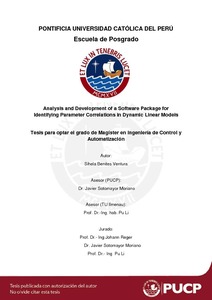| dc.contributor.advisor | Sotomayor Moriano, Juan Javier | |
| dc.contributor.advisor | Li, Pu | |
| dc.contributor.author | Benites Ventura, Sihela | es_ES |
| dc.date.accessioned | 2017-07-05T23:18:25Z | es_ES |
| dc.date.available | 2017-07-05T23:18:25Z | es_ES |
| dc.date.created | 2017 | es_ES |
| dc.date.issued | 2017-07-05 | es_ES |
| dc.identifier.uri | http://hdl.handle.net/20.500.12404/8928 | |
| dc.description.abstract | In the last two decades, the increasing appearance of new complex network systems,
which includes a large number of state variables and even greater amount of interconnections
(represented in hundreds of parameters) became a demanding task for modeling,
especially in the areas of pharmacology and bioengineering. Nowadays, there exists
a serious recognition of the importance of Identifiability (ID) since parameters can
be non-identifiable when it comes to make experimental design. As biological models
contain a considerably large amount of parameters, it is difficult to make a proper
estimation of them. Building a dynamic biological model involves not only the input and
output quantification but also the structural components considering the importance
of the information about the internal structure of a system and their components in
biology [4].
After many years of development , complex dynamic systems can be modeled using
Ordinary Differential Equations (ODE)s, which are capable of describing suitably the
dynamical systems behavior. Nevertheless, in the majority of cases, the parameters
values of a system are unknown; consequently, it is necessary to do estimation based on
experimental data to determine their values. Biological models , commonly complex
dynamic systems, include a large number of parameters and few variables to measure
hence the estimation of them represents a major challenge. An important step is to do
a previous identifiability analysis of the parameters before their estimation.
The concept of structural or a priori identifiability involves the question of examining
whether a system is identifiable or not given a set of ideal conditions (noise-free and enough input-output data) before a parameter estimation. Through the years, different
approaches and their respective software applications to perform a structural identifiability
analysis have been developed; however, does not have suitable measures to repair
the non-identifiable problem [11] [12]. On the contrary, the method developed by Li
and Vu [9] takes into consideration this subject by using parameter correlations as the
indicator of the non-identifiability problem and remedy this challenge by defining proper
initial conditions.
For all these reasons, the main goal of this work is to implement the method of
structural identifiability proposed previously, which allows the clarification of the identifiability
analysis for linear dynamic models and gives relevant information about the
conditions for a posterior experimental design and remedy if the model results nonidentifiable.
As the level of mathematical difficulty is not high since the basic idea is the
use of the output sensitivity matrix by calculations of Laplace transform and manageable
linear algebra, the implementation is efficient and simple, taking less than a minute to
analyze identifiability in simple models even examining different scenarios (values of
initial states, absence of input) at the same time in comparison to the calculation of
all the procedure by hand. As Maple is one of the best software to compute symbolic
calculations in the market today, is the application of choice to work with models
containing unknown parameters. | es_ES |
| dc.description.uri | Tesis | es_ES |
| dc.language.iso | eng | es_ES |
| dc.publisher | Pontificia Universidad Católica del Perú | es_ES |
| dc.rights | info:eu-repo/semantics/closedAccess | es_ES |
| dc.subject | Programas para computadoras--Desarrollo | es_ES |
| dc.subject | Modelos dinámicos | es_ES |
| dc.subject | Biología | es_ES |
| dc.title | Analysis and development of a software package for identifying parameter correlations in dynamic linear models | es_ES |
| dc.type | info:eu-repo/semantics/masterThesis | es_ES |
| thesis.degree.name | Maestro en Ingeniería de Control y Automatización | es_ES |
| thesis.degree.level | Maestría | es_ES |
| thesis.degree.grantor | Pontificia Universidad Católica del Perú. Escuela de Posgrado | es_ES |
| thesis.degree.discipline | Ingeniería de Control y Automatización | es_ES |
| renati.advisor.dni | 25558480 | |
| renati.discipline | 712037 | es_ES |
| renati.level | https://purl.org/pe-repo/renati/level#maestro | es_ES |
| renati.type | http://purl.org/pe-repo/renati/type#tesis | es_ES |
| dc.publisher.country | PE | es_ES |
| dc.subject.ocde | https://purl.org/pe-repo/ocde/ford#2.02.03 | es_ES |





